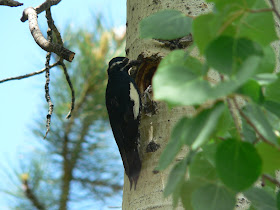 Garden of the Gods
Garden of the Gods view from Trail Ridge Road, RMNP
view from Trail Ridge Road, RMNPOn arrival at Garden of the Gods at 4.00 am on the first morning I was surprised to hear constant twittering in the darkness overhead. It wasn't until it got closer to sunrise that I realized these were Violet-green Swallows, performing a pre-dawn display which most likely began well before 4.00 am. I heard them again well before dawn in Rocky Mountain National Park, which is where these recordings were made.
.wav.png)
At the same location in RMNP a Tree Swallow sang its pre-dawn song; compared with the Violet-Green Swallow it is lower in pitch.
.wav.png)
North American tanagers have dawn songs that are extended versions of the day song; in addition the phrases are mostly given at a slower rate than the day song.
Western Tanager dawn song, 30 minutes before sunrise (RMNP).
.wav.png)
The day song (RMNP).

Members of the crow family have what are known as whisper songs that are used in courtship and at other times. This was a solitary Steller's Jay hidden in a conifer, giving its version of the whisper song, that includes some mimicry (American Goldfinch, Eurasian Starling and Least Sandpiper, RMNP).
BIAS.wav.png)
BIAS.wav.png)
A family of Common Ravens called back and forth early one morning at Little Horseshoe Park in RMNP.


A fledgling and adult Black-billed Magpie calling to each other. What's interesting here is that midway through the recording they switch calls. At first the fledgling is making begging calls and the adult the alarm, after 45 seconds they reverse. The adult "begging" call rises while the juvenile begging call is level (RMNP).
 juvenile begging call
juvenile begging call  adult alarm
adult alarm adult begging call
adult begging call juvenile alarm
juvenile alarmEmpidonax Flycatchers are best told apart by their calls or songs. Rocky Mountain National Park has four species, Cordilleran, Dusky, Hammond's and Willow. I recorded Dusky and Cordilleran but missed Hammond's, whose call is a pip (similar to Alder Flycatcher).
The call of the Dusky is a whit (similar to Willow).

The Cordilleran Flycatcher has a bisyllabic woo-hee call, given only by males. It is this call, known as the male position note, that best distinguishes Cordilleran Flycatchers from Pacific-slope Flycatchers, where the male call is more monosyllabic.
.wav.png)
Cordilleran Flycatcher song at dawn (Garden of the Gods).

This American Dipper was feeding young in a nest under a footbridge. It collected food just upstream, either floating and diving, or wading in shallow water along the edge of the stream (RMNP).
 alarm call
alarm callThe insect-like ringing sound of Broad-tailed Hummingbirds could be heard everywhere. The sound is made by vibration of the tapered tip of the outer primaries.
.wav.png)
The Warbling Vireos in Rocky Mountain National Park had a subtly different song to those I'm used to in the Delaware Valley.

A MacGillivray's Warbler singing beside a brook, RMNP.
.wav.png)
MacGillivray's Warbler call.
.wav.png)
At Garden of the Gods, White-throated Swifts called almost constantly as groups of them circled the cliffs.


Spotted Towhees were abundant there.
.wav.png)
.wav.png)
In comparison, the Green-tailed Towhee has a more complex song (RMNP).
.wav.png)
Green-tailed Towhee mew call.

Red-naped Sapsucker; the sapsuckers have slow, irregular drums (RMNP).
.wav.png)
Williamson's Sapsucker males and females are a great example of sexual dimorphism.


Calls of the nestlings:
.wav.png)
No comments:
Post a Comment